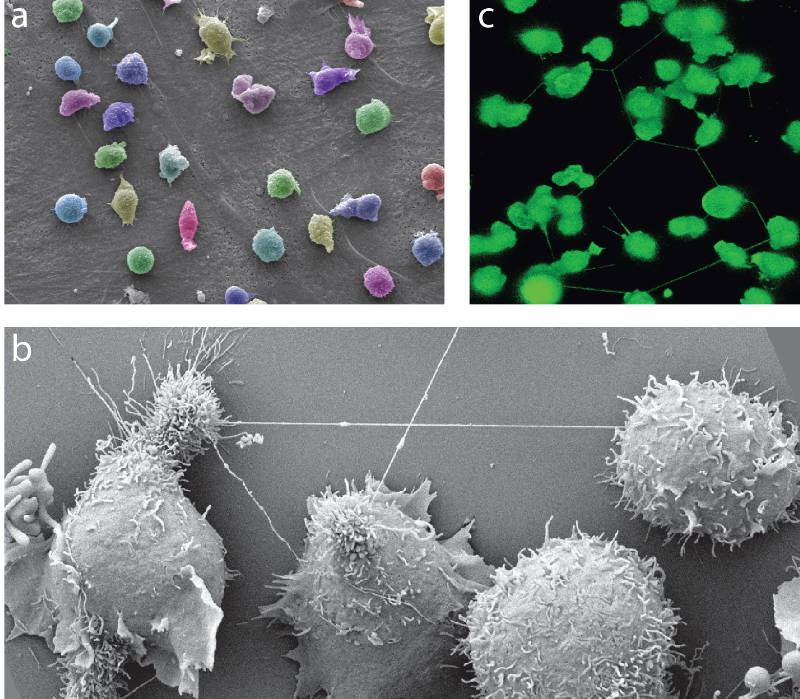Denis Corbeil Group
Organization and Dynamics of Plasma Membrane Protrusions: From Cell Biology to Regenerative Therapy

My laboratory studies the organization and dynamics of the plasma membrane protrusions. We are using distinct cellular models; stem (cancer stem) cells, epithelial cells and photoreceptor cells that have in common the expression of the cholesterol-binding pentaspan membrane glycoprotein prominin-1 (CD133). Prominin-1 has gained an enormous interest in the medical field since its cell surface expression enables the immune-isolation of somatic stem cells originating from various tissues notably brain and blood, and remarkably highlights cancer stem cells. Mutations in the PROM1 gene are associated with retinal diseases. We are utilizing prominin-1 as a dual marker of membrane protrusions and microdomains (lipid rafts).
Stem (Cancer Stem) Cells
I am interested in understanding the remodeling processes of the plasma membrane of stem (cancer stem) cells during cell division, migration and intercellular communication. We are using cells that originate from various sources notably the hematopoietic system. We developed experimental conditions that mimic the bone marrow hematopoietic stem cell niche (Fig. 1a). We have highlighted unexpected biological characteristics of primitive cells, which include asymmetric cell division of hematopoietic stem/progenitor cells, the release of prominin-1+ exosomes during the hematopoietic differentiation, and the formation of tunneling nanotubes between hematopoietic stem/progenitor cells or their leukemic counterparts as a new mechanism of intercellular communication (Fig. 1b, c). More recently, we have demonstrated that mesenchymal stromal cells produce and release migrasomes, a novel structure involved in intercellular communication (Video 1).
Differentiated Epithelial Cells
I am also fascinated by the organization of the apical membrane of differentiated epithelial cells. Prominin-1 shows a preference for membranes with a high curvature as those found in microvilli and cilium. We could demonstrate that the apical membrane is composed of distinct ganglioside-enriched membrane microdomains. For instance, GM1–enriched lipid rafts that contain prominin-1 are found in microvilli, whereas GM3–enriched ones are associated with the planar portion of the apical membrane. The primary cilium contains both gangliosides. Similar to stem cells, we found that the apical membrane is highly dynamic given that small prominin-1+ vesicles bud from the tips of microvilli and primary cilia. Such phenomena are interesting since the primary cilium plays a role in intercellular communication particularly during development.
Photoreceptors
Beside the fields of stem cells and epithelial cell polarity, a great interest in prominin-1 in eye research is emerging. The use of a third cell type model, i.e. photoreceptor cells, allows us to better understand the role of prominin-1 in the organization of biological membranes. Recessive and dominant mutations affecting prominin-1 have been described, all causing various forms of retinal pathologies. Diseases were reproduced in genetically modified mice carrying either a null allele or a dominant negative form of human prominin-1. The importance of prominin-1 for the vision is related to its subcellular localization. Prominin-1 is concentrated in newly synthesized membrane evaginations located at the base of the rod outer segment whereas it is distributed in the outer rims of open disc lamellae found in cones. In mammalian photoreceptors, prominin-1 binds to protocadherin 21 and their interaction organizes the outer segment membrane. Prominin plays a crucial role in the morphogenesis of fruit fly photoreceptors despite their different cellular organization suggesting that its implication in the architecture of functional subdomain(s) of membrane is conserved throughout the evolution.

Future Projects and Goals
I wish to pursue and develop my research on prominin molecules and their biochemical role in the organization and dynamics of plasma membrane protrusions. Furthermore, I would like to decipher the involvement of membrane protrusions such as tunneling nanotubes and migrasomes in tissue formation and in diseases such as cancer.
Methodological and Technical Expertise
- Biochemistry and molecular cell biology
- Isolation of stem cells
- Isolation of extracellular membrane vesicles
- Immunohistochemistry
- Scanning electron microscopy